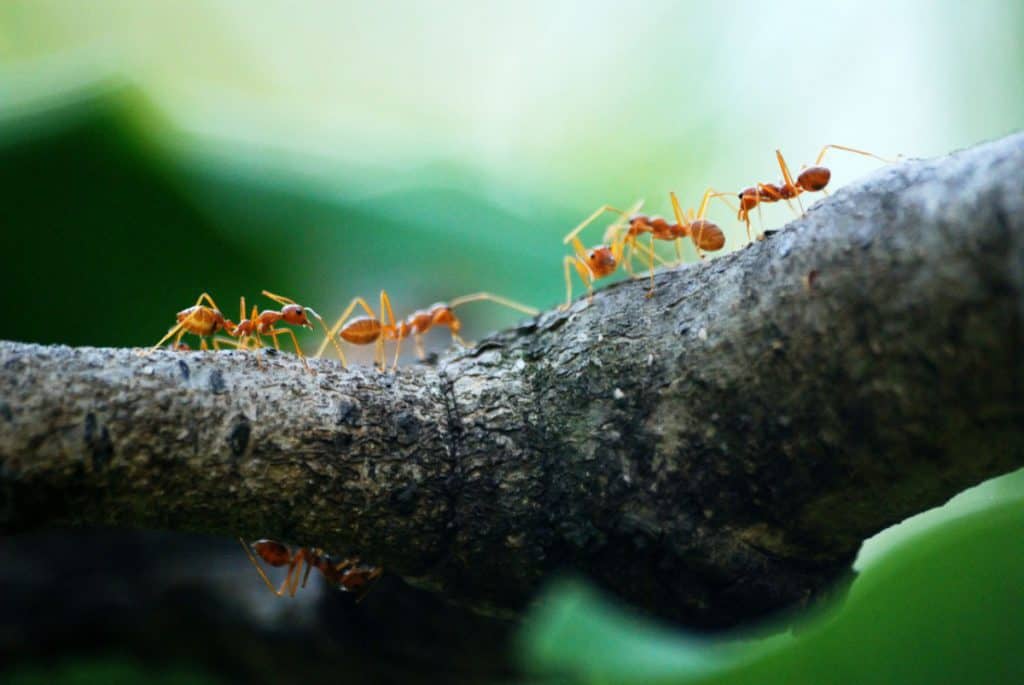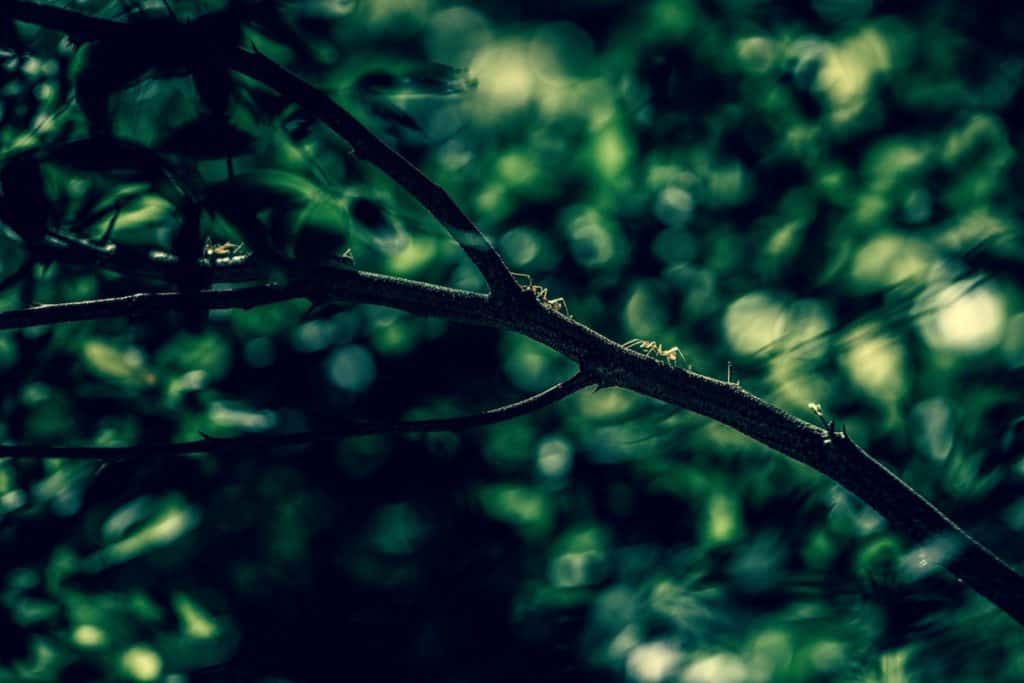
If you enjoy reading this article, why not check out our articles on What Can Ants Climb? This surprised me! and What Can Ants Damage? What you didn’t know.
Ants are known to be very persistent when it comes to invading your home. If you don’t take extra precaution and use deterrents, you can be sure that these little critters will be scurrying back in. What we really don’t know is that if ants rest during the night or if they are more active when the sunsets.
Are ants active at night?
Yes, they are. Ants continue their routine even if the sun goes down. They work 24/7 non-stop. However, certain species are exceptionally more active during the evenings.
Most ant species avoid the heat during the daytime. When the ground temp reaches a certain level, the ants stop foraging altogether. So it makes sense that ants would continue their work during the night when the weather is cooler. Some ants species that are famous for being active during the nights will be talked about in this article.
What Ants Do During The Night
What most ant species do is adjust their foraging habits according to temperature. Most ant species are affected by the ground temp, and this just goes to show that the cooler temp of the night is more appealing to them. However, there can be problems with this kind of setup. Ants that forage during the day get better food sources compared to ants that forage during the night. The critical thermal limit an ant has in the Sahara desert is 53.6 °C. Any hotter than that and the ants would cease any foraging activities.

So basically, ants mimic the same behavior they have during the cool morning hours during night time. But there are a few species that are worth mentioning
Species Of Ants That Are Active At Night
Here are a few of the ant’s species that are exceptionally active during the night.
African Big Headed Ants
About a Big Headed Ants: Also known as coastal brown ants. This species of ants have workers that grow to about 2 mm and soldiers who are about 3-4 mm in size. They have a light brown color, kind of like a gingery light brown hue with a shiny dark brown abdomen.
Where They Are Found: They are not particularly picky when it comes to their nesting habits. They can be found in rotten wood, beneath concrete pavers, under stones of the space between the tree and its bark. Although these are their preferred nesting sites, they do tend to invade your home ceilings and wall cavities.
Life Cycle: As for their life cycle, the eggs of this ant species, eggs start to hatch about 13 – 32 days. The larvae will then need anywhere from 22-39 days before it becomes a pupa. From there, another 10 – 25 days is required for the adult ant to emerge.
Are they Dangerous For Human? These species are known to invade homes during the night. They look for sources of food and will keep coming back. They are considered to be a major house pest not only because they are active at night but because they are also active during the day. You’ll often see them invade your kitchen, pantry, and bathroom. They are also notorious when it comes to electrical wiring damage. Their powerful mandibles allow them to chew through telephone cables and electrical wires. And these powerful mandibles are the reason why they are able to eat through food packages and plastic wrappings. So if you see ants invading in your kitchen or your pantry, you might just be looking at an African big-headed species.
Yellow Crazy Ants
About Yellow Crazy Ants: This is a very invasive species of ants. They are more commonly called as a long-legged ant. The” crazy” part of their name is due to this species fast and frantic movements. The average size is about 5 mm with yellow-orange and dark brown (abdomen) coloring.
Where it is Found? Yellow crazy ant nests can be found on the ground, under leaves, inside tree stumps, and sometimes discarded coconut husks. They can also be found in urban structures, rainforest, grassland, and woodland. However, this specific species of ant usually is not found above 1,200 elevations. They are also known to nest in electrical equipment, causing machine breakdowns and circuit breaks and some other extensive damage.
Life Cycle: You might be thinking of how fast this species can go since you’ve read about their name. This particular species can go anywhere from 37 – 402 m per year or 1100 m per year in colder climates.
Queens are said to have wings but can reproduce through budding. Budding is when a queen does not participate in a mating ritual, mostly by flight, but instead takes a small colony of workers and creates a new colony away from where the queen was born.
Typically, eggs of yellow crazy ants take about 18 to 20 days before they hatch and become a larva. The larvae then would need somewhere between 6 – 20 days before it turns into a pupa. Queens will take 30-34 days before it hatches into adults while workers take a shorter time, around 20 days only.
Are they Dangerous For Human? They are known to be active 24 hours a day, and many are concerned since they are a very invasive type of ants. Areas, where large infestations are experienced, are in the wet tropics in northern England and Australia, where people have had problems with daily life and sleeping due to these ants. If you want to learn more about Yellow Crazy Ants, check out our article What Can Ants Bite and Chew Through? for more fun facts.
Black Crazy Ants
About the Black Crazy Ants: These ants are also known as the longhorn crazy ants or the brown crazy ants. They are about 2.3 – 3 mm in size and has a dark brown to blackish color. Same as the previous crazy ants we’ve talked about. They are called “crazy” because of their erratic and fast movements. Their rapid movements can be attributed to their long legs. But what really sets these ants apart is that their bodies have white hairs all over.
Habitat of Black Crazy Ants: These little crawlers are very versatile when it comes to their nesting habits. They are known to nest in trees and on the ground. They are active during the day and also at night. You’ll usually spot these ants in farms, ships, and tropical vegetation. There are also instances when they nest under mulch, in concrete and sand. Their tolerance for the environment is extensive, which is why they can nest almost anywhere.
Life Cycle: They have a habit of foraging for food, even if it is a very long distance away from their nest. This makes them very hard to treat. They reproduce clonally, meaning eggs does not require a male to fertilize it.
Ghost Ants
About the Ghost Ants: Ghost ants are called that because of their pale, almost translucent legs. Their heads and thoraxes are dark compared to the rest of their body. Typically 4 mm in size, these ants are active during the day and night.
Where It is Found? Most of the time, these ants prefer soil as their nesting grounds, but they can also be found under rocks, logs, rotting wood, and underneath tree bark. They are known to be harmful to crops and wildlife. They are found in 154 geographical regions and are a common pest in the US.
Are They Dangerous for Humans: Unless you are ready to be stung by these feisty creatures, you might want the experts to deal with them. They are equipped with stings that they use to defend themselves when disturbed.
Pharaoh Ants
About the Pharaoh Ants: Now, these guys are especially included in the list because they are very active during the night. About 2 mm in size, they have a uniformly pale yellow or light yellow, brownish red-colored body. They are pretty hard to spot because they only form very unnoticeable foraging trails inside your home.
Where It Is Found? Now, these guys are very picky when it comes to their nesting sites. They don’t build soil or dirt mounds. They also don’t create galleries as other ants do. What they actually do is that they create their nests in naturally occurring crevices and voids. This can be especially bothersome because they usually would be found in wall cavities, in refrigerator insulation, in clothes, or behind baseboards.
Are They Dangerous For Humans: They are more attracted to nest indoors than outdoors, which is why they are not really a pest when it comes to plants and crops. However, they are very much attracted to sweet treats and can be a troublesome pest if they invade your home, a restaurant, or a grocery store. Our article Everything You Need to Know About Ants in Your Walls discusses how Pharaoh ants love to nest in your walls – give it a read and learn the proper precautions to take!
Conclusion
To summarize the whole article, ants are affected by temperatures, and their foraging habits will vary according to their environment. The hotter the ground temp gets, the faster they work, and when the ground temp reaches a certain level, foraging work ceases. Ants do hibernate during the cold months, but there are a few species that are known to prefer the colder weather during night time to forage. The list of ant species does not end with the few that are here. There are a few more; however, we pared it down to the most common species that you might see in your home. We mentioned that ants mimic their daily routine during the night, and this is true. During the early morning, when the ground temps are tolerable for ants, they do forage food. The foraging will then stop if it gets too hot and then continues again when the weather cools down in the evenings. Just be reminded that some species do sting or bite and can sometimes spray acid if disturbed. If you suspect an invasion of the stinging kind of ants, then it is better to let the experts handle it.
If you enjoyed reading this article, why not check out our articles on Where Do Ants Hide? Lets find out and Everything You Need to Know About Ants in Your Walls
Recent Posts
Tiny Black Bugs in Bathroom NO WINGS: What They Are and What to Do!
Finding tiny black bugs in your bathroom can be uncomfortable, to say the least. Especially if they are persistent, or they appear in very large numbers, which they often like to do. When it...
Tiny Black Bugs in Plant Soil - What Are They & What To Do About It
A short horror story: You get a new houseplant. You do your best to take care of it. You’ve ensured that it has the right soil, the right amount of sun, it gets enough water. And then one day, you...

